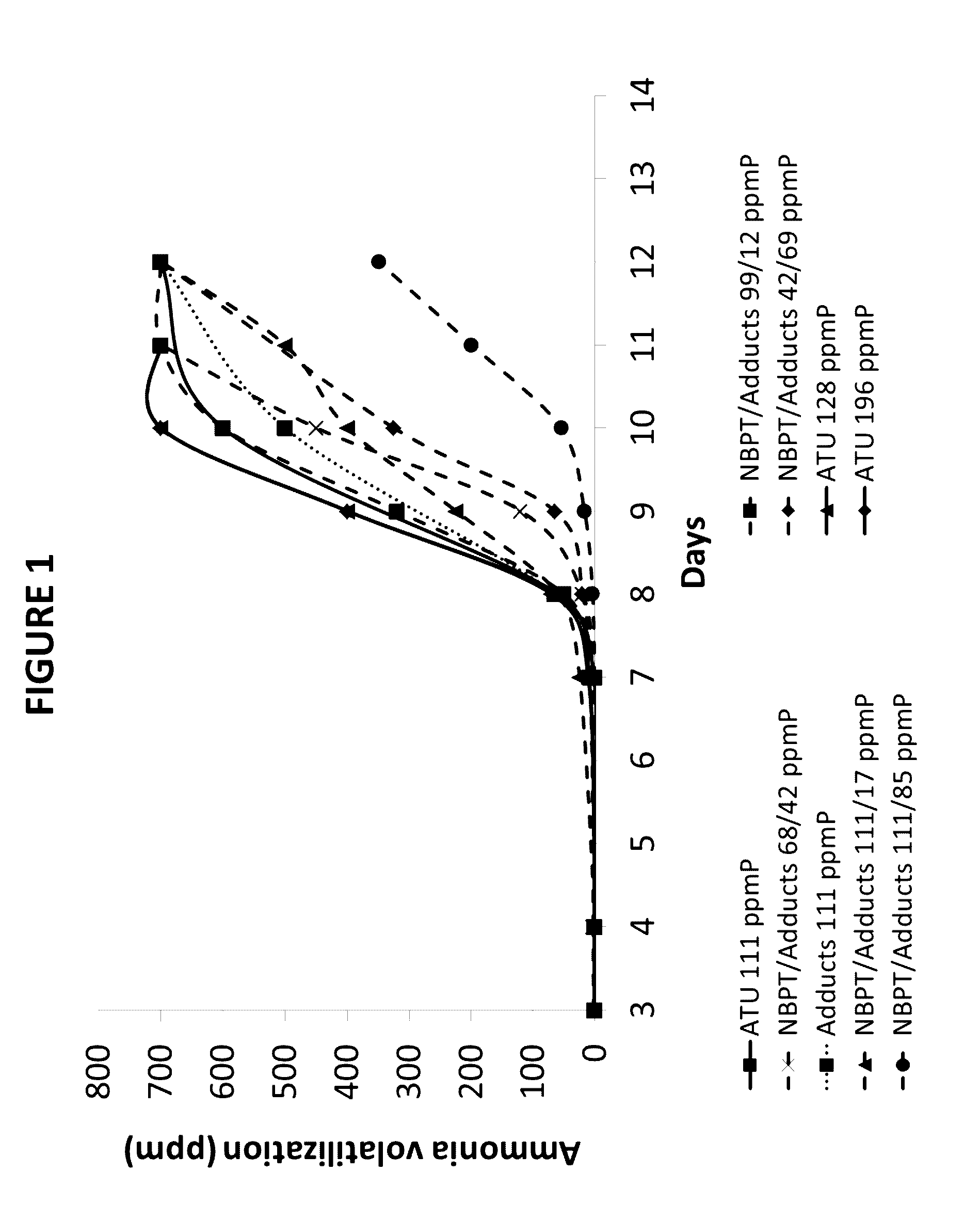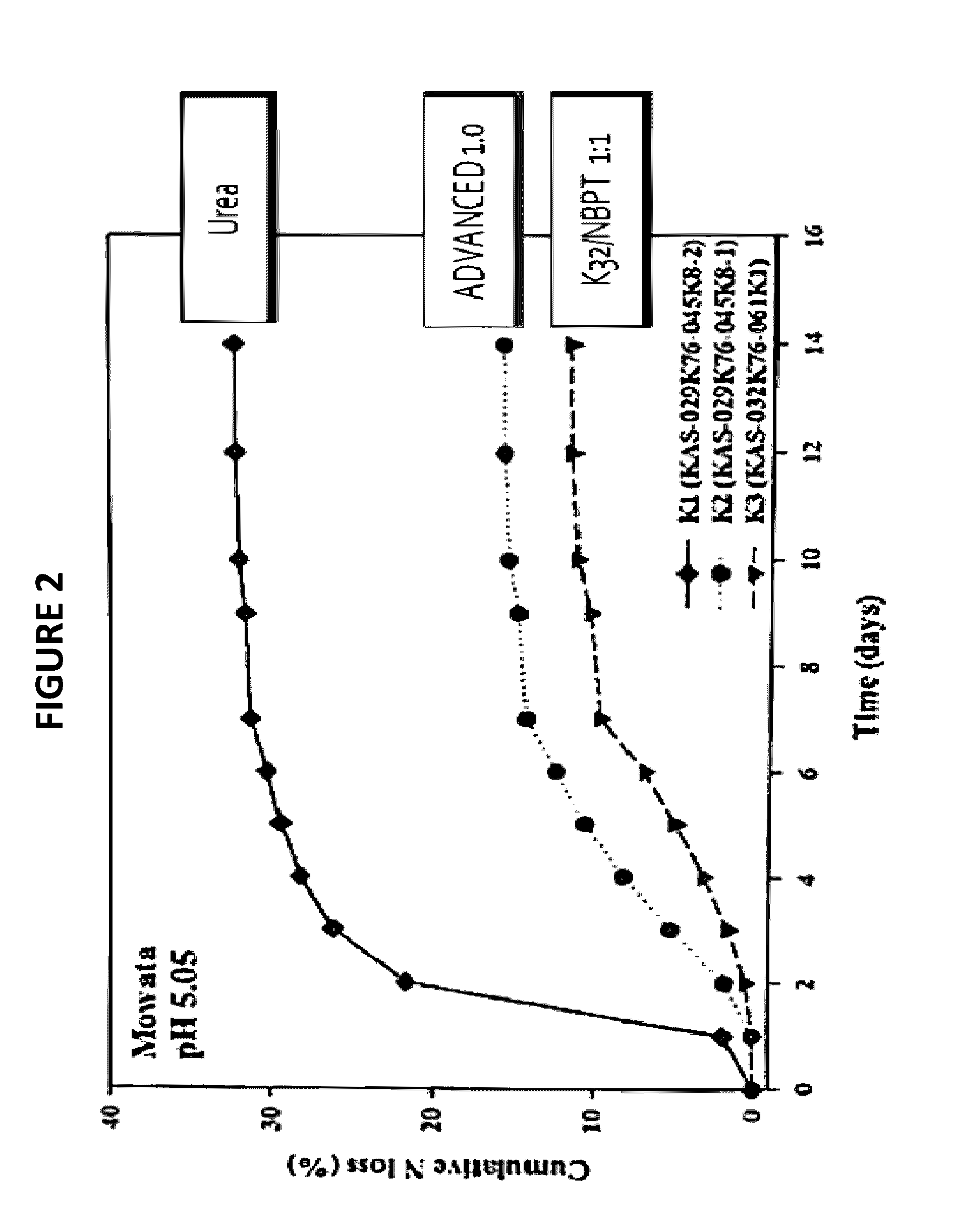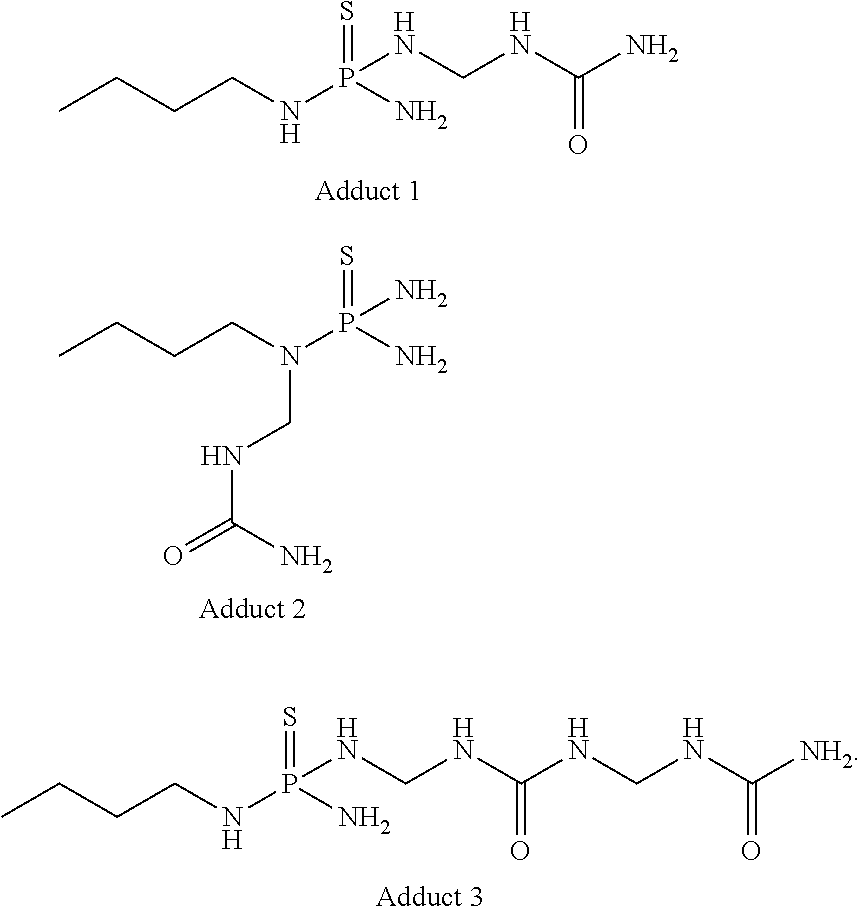Composition containing n-(n-butyl) thiophosphoric triamide adducts and reaction products
a technology of n-butyl thiophosphoric triamide and reaction products, which is applied in the field of compositions comprising urease inhibitors, can solve the problems of nbpt degradation at elevated temperatures into compounds that may not provide the desired inhibitory effect, and other solid materials to provide materials capable of inhibiting urease, particularly through granulation with urea, and achieves substantial urease inhibitory effects and low ammonia volatilization loss in us
- Summary
- Abstract
- Description
- Claims
- Application Information
AI Technical Summary
Benefits of technology
Problems solved by technology
Method used
Image
Examples
example 1
Synthetic Preparation of Adducts
[0069]As a representative example, to a solution of NBPT (5.0 g, 29.90 mmol) in N-methylpyrrolidone (NMP, 25 mL), was added to ACS-grade urea (1.79 g, 29.90 mmol, 1 equiv), followed by formalin (50%, 795 μL, 29.90 mmol, 1 equiv) at room temperature. The reaction mixture was stirred for 24 h. A homogeneous solution was obtained, containing ˜10% unreacted NBPT (as evaluated by HPLC) and adducts, among other species.
TABLE 1Adduct Formation Observed With Different Reactants and Reaction ConditionsReaction ConditionsConcentrationReactionNBPTRunof NBPTTempTimeconversion#Reactants(wt. %)Solvent(° C.)(hrs)(%, HPLC)1NBPT + HCHO15water25° C.248237% + ACS-Ua(1:1:1)2NBPT +13water25° C.2498.9dimethylolurea(1:1)3NBPT +13water25° C.14499.9dimethylolurea(1:1)4NBPT +13water40° C.2496dimethylolurea(1:1)5NBPT +9water40° C.2499.2dimethylolurea(1:4)6NBPT + reg-Ub0.027water25° C.247NBPT + reg-Ub0.027water25° C.2426(MAP addedas catalyst)8NBPT + HCHO15NMP25° C.246750% + ACS-...
example 2
Catalyst Effect
[0070]Urea (>99% pure) was treated at 260 ppm with a solution of AGROTAIN PRIME (i.e., NBPT-containing solution); note that the formaldehyde is already present in the urea. After one day, the resulting AGROTAIN® treated urea (ATU) was blended with monoammonium phosphate (MAP) 50:50 wt. %, diammonium phosphate (DAP) 50:50 wt. % or ammonium sulfate (AMS) 50:50 wt. %. The blends were retained for 6 months and samples were retrieved for analysis at defined time points. ATU was separated from the other blend components prior to analysis by HPLC for NBPT content and by LC-MS to characterize NBPT and adducts.
TABLE 2Adduct Formation in the Presence of MAPFreeNBPTLC-MS Peak AreaDay(HPLC)Free NBPTAdduct 1Adduct 2Adduct 302701421.50001170947.978.8002120637.9202.46.428.1390516.7253.18.545.0470311.8210.78.751.8750219.3238.211.974.3840196.0230.99.672.2930207.9200.710.573.4103094.3145.78.450.51130129.9179.38.171.7142075.2128.27.848.0161091.5138.28.258.1181076.9126.38.757.7211051.687...
example 3
Determination of Urease Inhibition
[0071]The effectiveness of urease inhibition was measured as follows. One tbsp of water was used to moisten 4 oz (˜100 g) of Tifton, GA soil of pH 7.7. The moist soil was placed in an 8 oz plastic cup with a tight-fitting lid. Approximately 1 tsp (˜2 g) of NBPT- and / or adduct-treated urea granules, was applied to the soil surface and the container was sealed. The container was incubated at room temperature for three days and analyzed for ammonia volatilization by inserting an ammonia-sensitive Dräger tube through the lid of the sealed container. In this way, the amount of ammonia present in the headspace of the container was quantified up to 600 ppm, the limit of the Dräger tube. In general, more effective urease inhibitors are characterized by having lower concentrations of ammonia in the headspace. All tests were run in duplicate in the presence of a positive control (i.e., untreated urea), which typically exhibits >600 ppm ammonia after 3 days fo...
PUM
| Property | Measurement | Unit |
|---|---|---|
| weight | aaaaa | aaaaa |
| weight ratio | aaaaa | aaaaa |
| catalytic activity | aaaaa | aaaaa |
Abstract
Description
Claims
Application Information
 Login to View More
Login to View More - R&D
- Intellectual Property
- Life Sciences
- Materials
- Tech Scout
- Unparalleled Data Quality
- Higher Quality Content
- 60% Fewer Hallucinations
Browse by: Latest US Patents, China's latest patents, Technical Efficacy Thesaurus, Application Domain, Technology Topic, Popular Technical Reports.
© 2025 PatSnap. All rights reserved.Legal|Privacy policy|Modern Slavery Act Transparency Statement|Sitemap|About US| Contact US: help@patsnap.com



